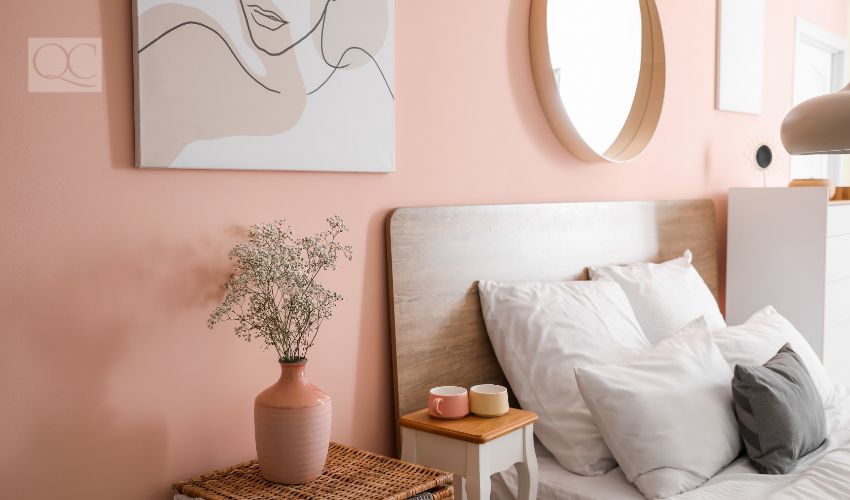Dream of a successful career in the home design industry? Today, we’re going to break down how to become a color consultant!
All you need to do is sit back, put your feet up, and relax.
By the time you’re finished reading, you’ll know everything you need to start your dream career and book your very first client in as little as 3-6 months!
What Does a Color Consultant Do?
First thing’s first: what does a color consultant actually do on a daily basis?
If you don’t know the answer to this question, no worries! That’s exactly what we’re here to discuss. So, let’s get into it!
If you want to start a career as a color consultant, these are the sort of responsibilities you’ll have for any given project:
- Conduct initial client consultations and follow-up appointments;
- Help clients determine their budget (and then stay within it as much as possible);
- Work with vendors, suppliers, and other home design professionals;
- Create color palettes for residential, retail, and commercial spaces, in a way that meets the clients’ needs and expectations;
- Provide color subject-matter expertise for everything from interior and exterior paint, to decor, to accessories, to fabric, etc.;
- Be an expert in both color theory and color psychology;
- Know how to work with furniture, appliances, flooring, lighting, etc.;
- Enhance a home’s curb appeal;
- Maintain a successful design business (should you choose to start your own business);
- And more!
If these are the types of tasks you know you’d enjoy doing on a regular basis, the guess what? You should get started as a color consultant and build your career!

Do You Need a Degree to Be a Color Consultant?
Technically, there are no strict qualification requirements in order for one to be a color consultant. Zippia.com found that, based on their data, approximately 58.3% of working color consultants have at least a Bachelor’s Degree under their belts – but that doesn’t necessarily mean specific design training. In theory, one could attempt to start a color consulting career fresh out of high school.
However, if you think that this means you can skip professional training, you couldn’t be more wrong!
The fact is, if you want success and longevity for your career, getting a proper education is the only true way to go. Why? Because prospective clients will NEVER want to invest money in a color consultant who can’t prove that they’re the real deal.
Within a home, color is not only important, it’s essential. Inside, it can evoke positive emotions and bring the entire space together. Outside, it can significantly improve curb appeal. As a result, selecting the wrong colors can be seriously disastrous!
And this is exactly why customers will only want to hire legitimate color experts that they can trust to deliver top-quality results. So, if you want to have a truly fruitful career, your best bet is to enter the industry having already completed accredited, reputable training.
Is Color Consulting a Good Career?
That really depends on YOU, your goals, and your preferences. Do you:
- Thrive when given the chance to be creative?
- Enjoy working with colors?
- Have a natural eye for design?
- Love working with people?
- Want a career where you’re making a legitimate, positive difference in people’s lives?
If you answered “yes” to these questions, then being a color consultant would not only be a good career for you – it’d be incredibly fulfilling. Moreover, you can make pretty good money in this line of work, too.
Salary Expectations as a Color Consultant
Of course, there’s no “one-size-fits-all” income as a color consultant, and it’s important to keep that in mind. Two color experts living in the same city can wind up making two entirely different salaries. This is because there are a number of impacting factors to consider, including (but not limited to):
- Where you live (e.g. big city vs. small town);
- The demand for color consulting services in your area;
- The quality of your design portfolio;
- How much prior hands-on experience you have;
- Your local competitors;
- The level of effort you put into networking;
- Whether you’re working as a color consultant part-time vs. full-time;
- Whether you’re employed by an existing design business or run one of your own;
- If your business also offers other design services, such as interior decorating, for example;
- How you price your service rates;
- How you market your business and services, etc.
That said, I can give you some approximate salary ranges for full-time color consultants, based on location. Here are some of the figures I’ve found:
- United States: Between $25,000 USD to $41,000 USD per year (Source: Glassdoor)
- Canada: Between $22,000 CAD to $73,000 CAD per year (Source: Glassdoor)
- United Kingdom: Between £14,000 GBP to £34,000 GBP per year (Source: Glassdoor)
- Australia: Between $50,000 AUD to $70,000 AUD per year (Source: Jora)

The Added Value of a Professional Certification
When you get proper color consultant training, you’re investing time, money, and effort into your expertise. As a result, once you graduate, you earn the right to price your design services in a way that properly reflects that.
Not to mention, if your business offers any additional design services, you can raise those rates as well!
Moreover, having a credible color consulting certification will do wonders when it comes to helping you stand out from the competition. Since setting yourself apart from the crowd is so important in this industry, getting properly trained and certified will not only elevate your career – it’ll definitely help you earn a higher income, too.
Did you know that ALL of QC Design School’s self-paced, online certification courses are accredited and internationally-recognized? Check out the full list of programs we currently offer here!
Okay, now that you know what it takes to be a color consultant, how can you actually become a color consultant?
Below are 4 steps that will walk you through the process!
Step 1. Decide What to Specialize In
This is undoubtedly the best place to begin. After all, it’s always smartest to approach your dream career with a game plan already in place. That way, you’ll be as prepared as possible, which will increase your chances of success!
So, do some brainstorming and jot down some notes. Think about the sort of color consultant you want to be – and don’t skimp on the details! Give it some real thought and be as thorough as possible.
Here are some questions you can answer to help you better determine the sort of career you want for yourself, where you might want to specialize, etc.:
- Would you prefer to work in residential spaces, commercial spaces, retail spaces, a combination of these areas, or all of these areas?
- Are there certain rooms in a home (i.e. kitchens, bedrooms, living rooms, etc.) that you’d prefer to specialize in more than others?
- Do you want to strictly offer paint color consulting services, or also lend your expertise towards accessorizing, decor, etc.?
- Do you want to specifically assist clients going through transitional periods, such as getting their homes ready to sell on the real estate market?
- Who is your target clientele? How will you market your color consulting services to them?
- Would you like to pair your color consultant services with any other complementary design services, such as interior decorating or home staging?

Step 2. Take a Course on How to Become a Color Consultant
At this point, it’s time to decide where – and how – you’d like to obtain your professional color consulting education. As such, the first step is to determine whether you’d like your training to be done in-person or online.
Brick-and-Mortar Training
In-person schooling is the obvious choice if you’re the type of learner who excels most when physically surrounded by your peers and instructor. However, one downside to keep in the back of your mind is that brick-and-mortar courses can get ridiculously expensive.
Plus, you also need to factor in the fact that you’ll be forced to go at the same pace as everyone else. Thus, if your color consultant program is, say, 6 months long, you won’t be able to graduate any sooner than that.
Online Training
Online training, on the other hand, can be less expensive seeing as there is no physical campus to maintain. It can often be done at YOUR preferred pace, which is definitely an added bonus.
QC Design School‘s distance learning environment, for instance, is 100% self-paced! Once you enroll in your design program, you’ll have a full 2 years to complete it. But of course, during that 2-year window, you get total control over when and how often you want to work on your studies.
This means that if you were to devote a mere 1-2 hours per week on your studies, you could graduate and obtain your internationally-recognized certification in as little as 3-6 months!
QC Design School’s Color Consultant Course
For aspiring color experts, QC’s Color Consultant Course will teach you everything you need to know! In this 3-unit online program, you’ll discover:
- Color theory and color psychology;
- The role of a color consultant and how to be successful;
- The color wheel, color terminology, and color schemes;
- Factors that influence color perceptions, such as lighting, undertones, and texture;
- How to build custom color palettes for any type of project;
- How to determine focal points within a room and use them to your client’s advantage;
- What it takes to bring a color palette to life through the use of paint, accessories, decor, textures, and more;
- Paint finishes, as well as ceiling/trim/wallpaper colors;
- How to build a strong relationship between art and your client’s room(s);
- How to start and run your very own design business;
- And SO much more!
After you’ve enrolled in this course, you’ll receive your login details for QC Design School’s Online Student Center within 1-2 business days. From the OSC, you’ll gain direct, online access to your digital textbooks, 25 practical assignments, instructional videos, etc.
Of course, we’ll also mail you a physical copy of your course materials, too. Included in this physical set of course materials is a fan deck and color wheel to assist you throughout your learning journey. You should receive everything in the mail within 1-2 weeks after you enroll.
The best part of this entire experience?
Once you graduate, you’ll receive your internationally-recognized International Color Consulting Professional (ICCP) certification! Remember: this ALSO serves as your official designation, too. Not only will this look exceptional on your resume – it’ll be sure to impress all future clients and/or employers alike!
Read the full Color Consultant Course breakdown and curriculum here!

Step 3. Decide on Your Career Path
Once you complete your color consultant training, you need to figure out how you plan to approach your career before diving in head-first. Remember what we said earlier: you’ll be a lot more likely to be successful if you go into things with a game plan in place.
Here, the biggest question to answer is whether you’d like to be hired by a design business or launch one of your very own.
Here are some of the pros and cons for both options:
Joining an Existing Design Business
Pros
- No start-up costs or investments required on your end
- Job stability
- A set hourly or yearly income
- Business likely already has a roster of clients, industry connections, preferred vendors, etc. (meaning, you won’t need to procure all of these from scratch)
- There will more than likely already be a marketing team in place, so you won’t have to handle the brunt of this work either
Cons
- Limited flexibility – you’ll have to abide by the hours/schedule given to you by your employer
- Restricted room for growth – you’ll need approval before exploring new ventures, taking on more responsibility, trying new things, etc.
- Salary limit – you’ll only be able to increase your income when your employers allows it
- You’ll be expected to reflect the company’s brand, rather than establish one of your own
- The same goes for upholding the business’s overall model, values, and message – which may not always align with your own
Start Your Own Design Business
Pros
- You get to be your own boss
- Your schedule (a.k.a. when and how often you work each week) is entirely up to you
- The sky is the limit, in terms of potential career opportunities
- You get to set your own service rates, so you can make as much as you want
- Your brand, business message, goals, etc. are 100% under your control
- Flexibility to book whichever clients/projects you want (and also not book the ones that don’t align with your values or goals)
- Total freedom to create the design career that works best for YOU
Cons
- Will require some sort of start-up investment to get things off the ground
- Requires a LOT of time and hard work
- Building up your clientele, developing your network, branding yourself, and successfully marketing your services will be all up to you
- It might take a bit of time to start turning a profit
- Requires a lot of self-discipline, persistence, and patience
Not sure which path is right for you? Check out QC Design School’s Graduate Features to see how others have chosen to pursue their careers, which route was most fruitful for them, and why!

Step 4. Network with Realtors, Interior Designers, and Other Consultants
Networking will be your BEST FRIEND as you become a color consultant and advance in your career. The home design industry is a tight-knit community. Thus, it won’t take long for you to meet and/or become acquainted with the other consultants in your local area, in addition to contractors, suppliers, and other types of designers.
“But wait,” you might be thinking, “why do I need to become friends with other color consultants? Aren’t they supposed to be my competition?”
Sure – but that definitely does NOT mean they aren’t also your allies. The reality is, you’ll have a much more successful career if you establish positive connections with others in the community… And that includes your competitors!
After all, when you network, you’re increasing your chances of future collaborations, as well as getting referrals. Even other color consultants can potentially send a potential client your way, if their own schedule is completely booked. So long as they trust that you’d do the same for them, if the shoe were ever on the other foot, you’ll find that everyone within the design industry is typically happy to help one another out.
Ultimately, you’ll have a longer, more fruitful career if you network with other designers and color consultants.


